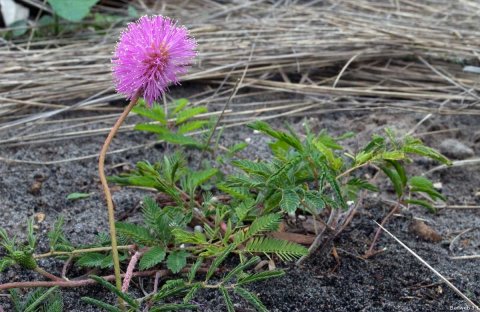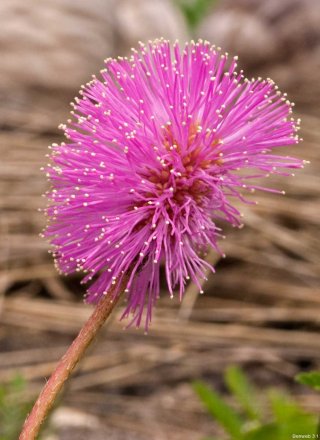The Saturday before Mother’s Day, I took Grammy and the boys up to Meadow Beauty Nursery in Lake Worth. Mom (Grammy) has a little sandyard that she wants to fill in with something pretty, so we went a-lookin’, and I decided that I needed some ground cover to fill in under my Bahama Strongbark. It would make a nice surprise for Mommy when she got home (just in time for Mother’s Day).
The minute we got back from the nursery, I planted the flowers and grasses that we got, because I didn’t want to let the it-looks-like-rain weather pass. And boy, what a reward I got! One of them, the little pink Mimosa strigillosa, commonly known as powderpuff or sunshine mimosa, has already flowered!
Powderpuff mimosa has a low growth habit that makes it an ideal ground cover, and pretty little pink blossoms that add some color to your yard:
The plant is part of the legume family, so it has little seed pods and it can fix nitrogen in the soil. Unlike some other low-growing and pretty groundcovers that you’ll find in Florida (I’m thinking of you, Tribulus cistoides, AKA puncture vine!), it’s native, not exotic, and it doesn’t have thorns, so it’s really an excellent little plant if you’re looking for color and coverage.
It can even be interplanted with lawn grass. According to the very informative Lee County UF/IFAS circular, grasses will grow through it and can be mowed without affecting the usually lower growing mimosa. I’m looking forward to seeing how it works in my garden.
Etymology: The specific epithet strigillosa derives from the fact that the leaves are covered with stiff hairs or bristles (strig- = referring to stiff hairs or bristles [strigosa / strigillosa]).
The genus name, which, according to the Online Etymology Dictionary (which I rarely consult because the Florida native organisms I find are so rarely explained therein!) was
coined in 1731 from L. mimus, “mime” + –osa, adj. suffix (fem. of –osus); so called because some species (including the common Sensitive Plant) fold leaves when touched, seeming to mimic animal behavior.
Kind of cool, huh?
According to some writers, M. strigillosa is not a sensitive plant, but the leaves of the one in my yard do indeed curl up when touched, so I’m not sure where this confusion comes from. Craig Huegel writes that “The leaves are not sensitive to touch as is that of sensitive briar (Mimosa quadrivalvis) – a plant it is sometimes confused with.” I’m not sure who would confuse the two, though, as M. quadrivalvis has thorns and M. strigillosa is the only thornless species in Florida. Perhaps the confusion is in the horticultural trade over M. pudica, the archetypal sensitive briar, and M. strigillosa, which might in fact not be sensitive.
I’m hoping that, even though it’s described as not a very competitive species, I’ll be able to get it to spread across the landscape and I can start pulling up the pretty but very aggressive (and exotic) Richardia grandiflora. This native mimosa is not only attractive to the bees, like the exotic R. grandiflora, but it’s also a larval plant for the little sulphur butterfly (Pyrisitia formerly and still sometimes Eurema] lisa).
As usual, the functional and flowery native plays a more complete ecological role in the landscape; such plants really should be promoted over the showy but sterile exotics.



How can I propagate Sunshine Memosa in the landscape?